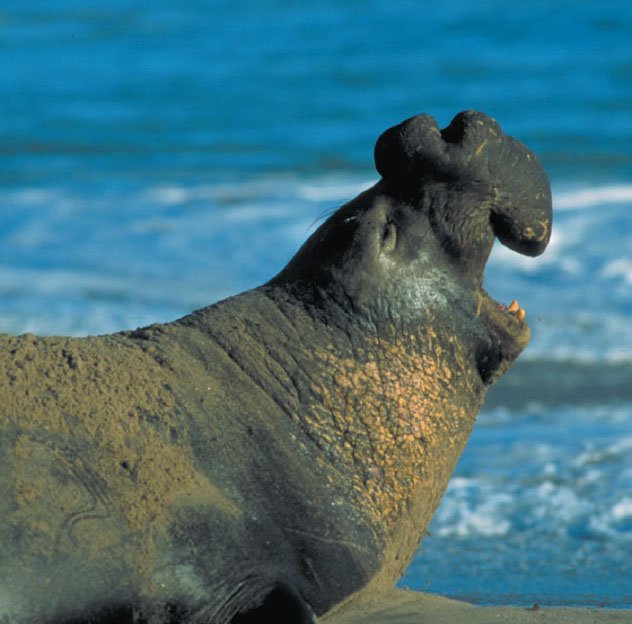Elephant Seal
The elephant seal was named for its large snout that resembles an elephant’s trunk. To attract females, the snout is inflated up to 12 inches (30 cm) long during the mating season. The elephant-like snout gives the seal a very deep, bellowing roar, and this display is supposed to ward off any rivals.
There are two species of the elephant seal—the northern and the southern. The southern elephant seal is found in the Antarctic while the northern seal is found along the west coast of North America.
Elephant seals are the largest of the pinniped carnivores. While they are somewhat clumsy on land, they are very graceful in the water and can propel themselves through the water with ease. It has been reported that an elephant seal is capable of diving over 3,000 feet (914 m). Its main diet consists of fish and squid. It has long canine teeth, but most of the teeth are below the gum line.
The male is dark gray while the female is brown. They are insulated from the cold waters by a layer of fat, or blubber. This is not only an insulator for warmth but also a food storage reserve.
The size difference between the male and female elephant seal is the largest difference between any male and female mammal. It is very difficult to actually weigh these huge animals. The female’s length is 50 percent less than the males and her weight is 25 percent less.
The elephant seal comes ashore to breed in September. They sometimes travel great distances of up to 3,000 miles (4,828 km) to get to their breeding area. The female gives birth to one offspring in September or October, after a gestation period of almost a year. The seal pup will gain four times its birth weight in just three to four weeks. The female will mate again after the baby is 18–21 days old. The mother will remain on land for 25 days to nurse her pup. During this time, they will not eat.
They may lose as much as 600 pounds (272 kg) during this time. The males do not eat, either. They are too busy trying to protect their females from other males. Besides roaring and inflating their snout, the males will push at each other, trying to defeat the rival. Sometimes their snouts become covered with blood from hitting each other.
With a lot of physical activity on land, the seals tend to sleep deeply. It is said that someone could actually sit on top of one of them and they would not even know it.
Elephant Seal
Pinnipedia • Phocidaev
Mirounga leonina, M. angustirotris
Weight: 7,700 pounds (3,500 kg)
Length: 21.3 feet (6.5 m)
Special Design Feature: The elephant
seal is able to dive as deep as 3,000
feet (914 m) without being crushed by
the pressure of the water.
Did You Know? The elephant seal is the
largest of the pinniped carnivores.

Marvels of Creation: Sensational Sea Creatures
Brings the world of the sea alive in a unique and colorful way with photographs, a page of facts and commentaries.
Browse Kids BookRecommended Resources
- © 2025 Answers in Genesis
- Privacy Policy
- Contact
- About


